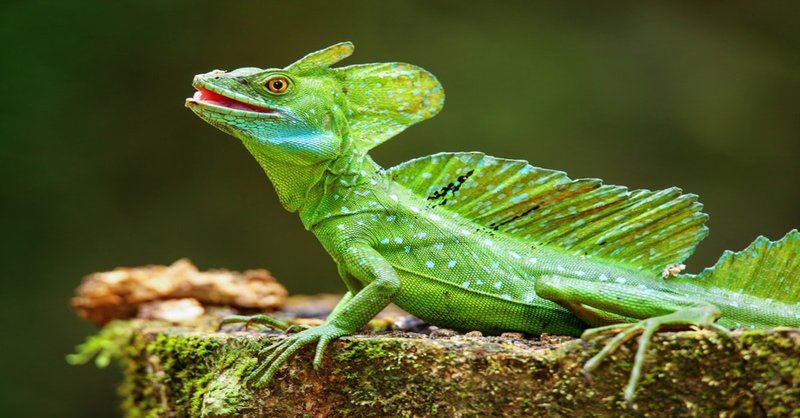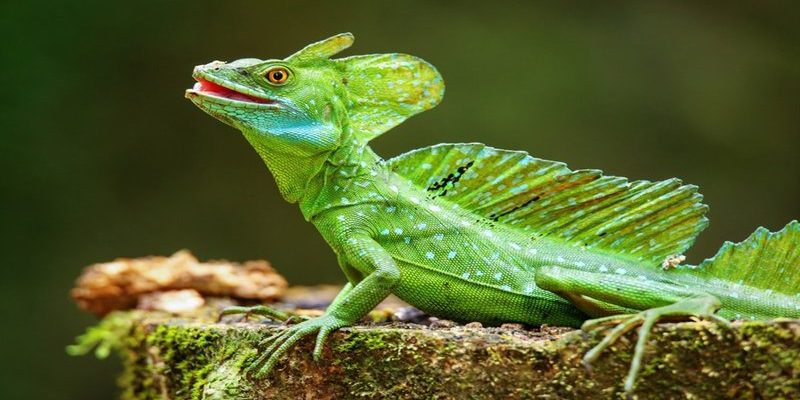
Originating from Central and South America, basilisks come in a few varieties, but they all share some common traits that make them absolutely captivating. Whether you’re a budding herpetologist or just someone curious about the wonders of nature, uncovering the secrets of the basilisk lizard from its unique adaptations to its habitat is an adventure worth taking. So, grab a cup of coffee, and let’s dive into the world of these fascinating reptiles!
1. The ‘Jesus Christ Lizard’
You might be wondering why the basilisk is nicknamed the “Jesus Christ lizard.” The name comes from its incredible ability to run on water for short distances. When threatened, these lizards can dash across the surface of ponds or streams, making it seem like they’re walking on water—hence the nickname. It’s a sight straight out of a nature documentary!
But how do they do it? The secret lies in their large feet, which have flaps of skin that spread out when they sprint. This helps to distribute their weight over a larger area, creating just enough surface tension to keep them afloat. In essence, they become tiny, green superheroes! Isn’t that just wild?
2. Amazing Adaptations
Basilisk lizards are not just fast; they have a whole arsenal of adaptations that help them survive in the wild. One of the most notable features is their dewlaps—the flap of skin under their throat that they can expand for communication or to attract mates. When you see a basilisk puffing out its dewlap, it’s like they’re saying, “Hey, look at me!”
They also have impressive camouflage skills. Their green coloration allows them to blend seamlessly into the lush foliage of their rainforest habitat. This natural disguise helps them evade predators, making it easier for them to sneak away when danger is near. It’s like they have a built-in invisibility cloak!
3. Unique Diet and Hunting Techniques
Basilisk lizards are primarily insectivores, meaning they feast on insects. However, they aren’t picky eaters. Their diet can include small fruits and flowers, too. When hunting, they employ a fascinating technique—using their keen vision to spot prey, they can whip their heads quickly to catch insects mid-flight. Talk about agility!
Here’s a quirky fact: their tongues are long and sticky, much like a chameleon’s. They can flick their tongues out to grab insects quickly, making them effective hunters. So, if you ever find yourself in a rainforest, don’t be surprised if you see them catching their lunch in a flash!
4. Social Creatures with Complex Behaviors
You might think of lizards as solitary animals, but basilisk lizards are quite social. They thrive in groups, often seen basking together on branches or rocks. This social behavior isn’t just for fun, though—it’s a survival tactic. By staying close to one another, they can keep an eye out for predators and warn each other of danger.
During mating season, male basilisks show off their colors and perform elaborate displays to attract females. They often engage in head-bobbing and dewlap-flaring contests. It’s like a little dance-off in the trees! Watching them interact can be quite a spectacle, revealing a side of reptiles that many people overlook.
5. Their Dazzling Coloration
Basilisk lizards are known for their striking colors. Most commonly, you’ll see them in shades of bright green, but some species sport earthy tones to blend in better with their surroundings. This dazzling appearance isn’t just for beauty; it plays a crucial role in their survival, helping them camouflage more effectively among the leaves and branches.
Interestingly, young basilisks are often more vibrant than adults. As they grow, their colors can dull down, helping them avoid predators. This vibrant coloration not only makes them stunning to look at but also reflects their health and vitality, making it easier for potential mates to choose a partner.
6. The Basilisk’s Habitat
These lizards are primarily found in tropical rainforests and near rivers and streams. They thrive in humid environments where there’s plenty of vegetation. Think of lush greenery, tall trees, and flowing water—all essential elements of their habitat that support their active lifestyle.
Living in such rich environments offers them plenty of food and refuge from predators. They like to bask on branches or rocks to soak up the sun, and when threatened, they’ll often dive into the water to escape. Their choice of habitat greatly influences their behavior and survival strategies.
7. Breeding and Lifecycle
When it comes to reproduction, basilisk lizards have some interesting traits. Females lay eggs, usually in the soil near water. After a few weeks, tiny hatchlings emerge, ready to face the world. From the moment they hatch, they must rely on their wits to survive, as they are on their own straight away.
Interestingly, the baby lizards are miniature versions of adults, fully capable of climbing trees and running on water almost immediately. It’s a tough life, but these little guys are born ready to take on the challenges of their environment!
8. Fascinating Cultural Significance
Beyond their biological wonders, basilisk lizards hold cultural significance in some areas. In certain local legends, they are seen as symbols of bravery and agility. Their ability to run on water has inspired stories that capture the imagination, sometimes being depicted in local art and folklore.
For many, they represent the rich biodiversity of Central and South America. Conserving these unique animals means preserving a part of the culture and ecosystem they belong to. It’s a reminder of how intertwined nature and culture can be.
9. Conservation Status
Like many species around the world, basilisk lizards face threats from habitat destruction and climate change. Deforestation for agriculture and urban development can dramatically alter their habitats, making it harder for them to thrive. Understanding their role in the ecosystem is key to conservation efforts.
Conservation groups work tirelessly to protect these lizards and their environments, promoting awareness about the importance of biodiversity. Supporting these initiatives can make a real difference in ensuring future generations can enjoy these remarkable creatures.
10. Keeping Basilisk Lizards as Pets
If you’ve ever thought about keeping a basilisk lizard as a pet, there are a few things to consider. First, they require a spacious enclosure with plenty of climbing opportunities and water features. These lively lizards need room to run and climb—remember, they’re no couch potatoes!
Additionally, their diet must include live insects, which means you’ll need to be prepared for some responsibilities. Though they can be captivating pets, they do require a commitment like any other living being. Ensure you’ve done your research and can provide the right care for these fascinating reptiles.
In conclusion, the basilisk lizard is more than just a creature that runs on water. With a host of unique adaptations, social behaviors, and a stunning appearance, it showcases the wonders of nature. Whether you’re simply fascinated by wildlife or considering a pet, there’s a lot to appreciate about these extraordinary lizards. So, take a moment to admire these little wonders the next time you come across them!

